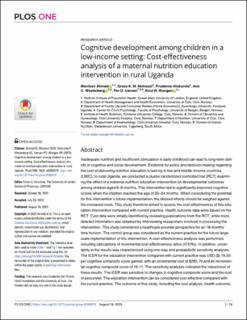| dc.contributor.author | Ahmed, Montasir | |
| dc.contributor.author | Muhoozi, Grace Kyamazima Mehangye | |
| dc.contributor.author | Atukunda, Prudence | |
| dc.contributor.author | Westerberg, Ane Cecilie | |
| dc.contributor.author | Iversen, Per Ole | |
| dc.contributor.author | Wangen, Knut Reidar | |
| dc.date.accessioned | 2023-08-25T07:27:24Z | |
| dc.date.available | 2023-08-25T07:27:24Z | |
| dc.date.created | 2023-08-18T21:30:10Z | |
| dc.date.issued | 2023 | |
| dc.identifier.citation | PLOS ONE. 2023, 18(8). | en_US |
| dc.identifier.issn | 1932-6203 | |
| dc.identifier.uri | https://hdl.handle.net/11250/3085725 | |
| dc.description.abstract | Inadequate nutrition and insufficient stimulation in early childhood can lead to long-term deficits in cognitive and social development. Evidence for policy and decision-making regarding the cost of delivering nutrition education is lacking in low and middle-income countries (LMIC). In rural Uganda, we conducted a cluster-randomized controlled trial (RCT) examining the effect of a maternal nutrition education intervention on developmental outcomes among children aged 6–8 months. This intervention led to significantly improved cognitive scores when the children reached the age of 20–24 months. When considering the potential for this intervention’s future implementation, the desired effects should be weighed against the increased costs. This study therefore aimed to assess the cost-effectiveness of this education intervention compared with current practice. Health outcome data were based on the RCT. Cost data were initially identified by reviewing publications from the RCT, while more detailed information was obtained by interviewing researchers involved in processing the intervention. This study considered a healthcare provider perspective for an 18-months’ time horizon. The control group was considered as the current practice for the future large-scale implementation of this intervention. A cost-effectiveness analysis was performed, including calculations of incremental cost-effectiveness ratios (ICERs). In addition, uncertainty in the results was characterized using one-way and probabilistic sensitivity analyses. The ICER for the education intervention compared with current practice was USD ($) 16.50 per cognitive composite score gained, with an incremental cost of $265.79 and an incremental cognitive composite score of 16.11. The sensitivity analyses indicated the robustness of these results. The ICER was sensitive to changes in cognitive composite score and the cost of personnel. The education intervention can be considered cost-effective compared with the current practice. The outcome of this study, including the cost analysis, health outcome, cost-effectiveness, and sensitivity analysis, can be useful to inform policymakers and stakeholders about effective resource allocation processes in Uganda and possibly other LMIC. | en_US |
| dc.language.iso | eng | en_US |
| dc.rights | Navngivelse 4.0 Internasjonal | * |
| dc.rights.uri | http://creativecommons.org/licenses/by/4.0/deed.no | * |
| dc.subject | cognitive development | en_US |
| dc.subject | nutrition | en_US |
| dc.subject | cost-effective | en_US |
| dc.subject | nutrition education intervention | en_US |
| dc.subject | intervention | en_US |
| dc.title | Cognitive development among children in a low-income setting: Cost-effectiveness analysis of a maternal nutrition education intervention in rural Uganda | en_US |
| dc.title.alternative | Cognitive development among children in a low-income setting: Cost-effectiveness analysis of a maternal nutrition education intervention in rural Uganda | en_US |
| dc.type | Peer reviewed | en_US |
| dc.type | Journal article | en_US |
| dc.description.version | publishedVersion | en_US |
| dc.source.volume | 18 | en_US |
| dc.source.journal | PLOS ONE | en_US |
| dc.source.issue | 8 | en_US |
| dc.identifier.doi | https://doi.org/10.1371/journal.pone.0290379 | |
| dc.identifier.cristin | 2168069 | |
| cristin.ispublished | true | |
| cristin.fulltext | original | |
| cristin.qualitycode | 1 | |

